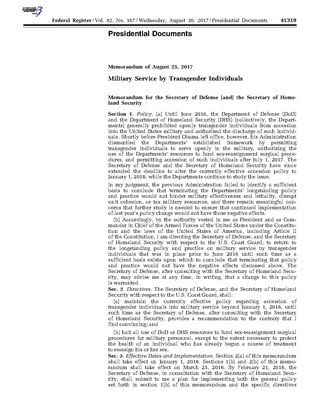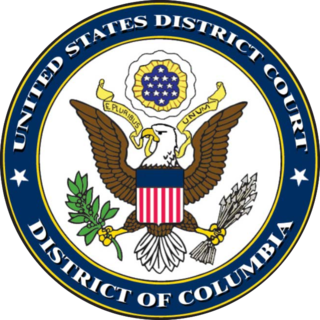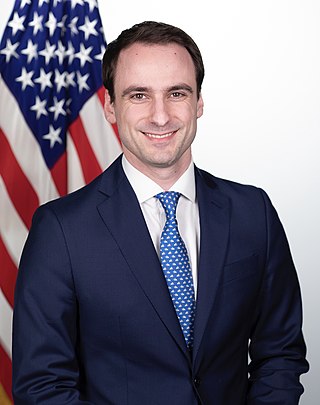
The United States National Security Council (NSC) is the principal forum used by the president of the United States for consideration of national security, military, and foreign policy matters. Based in the White House, it is part of the Executive Office of the President of the United States, and composed of senior national security advisors and Cabinet officials.
A unified combatant command, also referred to as a combatant command (CCMD), is a joint military command of the United States Department of Defense that is composed of units from two or more service branches of the United States Armed Forces, and conducts broad and continuing missions. There are currently 11 unified combatant commands, and each is established as the highest echelon of military commands, in order to provide effective command and control of all U.S. military forces, regardless of branch of service, during peace or during war time. Unified combatant commands are organized either on a geographical basis or on a functional basis, e.g., special operations, force projection, transport, and cybersecurity. Currently, seven combatant commands are designated as geographical, and four are designated as functional. Unified combatant commands are "joint" commands and have specific badges denoting their affiliation.

The National Space Council is a body within the Executive Office of the President of the United States created in 1989 during the George H. W. Bush administration, disbanded in 1993, and reestablished in June 2017 by the Donald Trump administration. It is a modified version of the earlier National Aeronautics and Space Council (1958–1973).
A presidential memorandum is a type of directive issued by the president of the United States to manage and govern the actions, practices, and policies of the various departments and agencies found under the executive branch of the United States government. It has the force of law and is usually used to delegate tasks, direct specific government agencies to do something, or to start a regulatory process. There are three types of presidential memoranda: presidential determination or presidential finding, memorandum of disapproval, and hortatory memorandum.
Cyberwarfare is the use of computer technology to disrupt the activities of a state or organization, especially the deliberate attacking of information systems for strategic or military purposes. As a major developed economy, the United States is highly dependent on the Internet and therefore greatly exposed to cyber attacks. At the same time, the United States has substantial capabilities in both defense and offensive power projection thanks to comparatively advanced technology and a large military budget. Cyberwarfare presents a growing threat to physical systems and infrastructures that are linked to the internet. Malicious hacking from domestic or foreign enemies remains a constant threat to the United States. In response to these growing threats, the United States has developed significant cyber capabilities.

The space policy of the United States includes both the making of space policy through the legislative process, and the implementation of that policy in the United States' civilian and military space programs through regulatory agencies. The early history of United States space policy is linked to the US–Soviet Space Race of the 1960s, which gave way to the Space Shuttle program. At the moment, the US space policy is aimed at the exploration of the Moon and the subsequent colonization of Mars.
Presidential Policy Directive 20 (PPD-20), provides a framework for U.S. cybersecurity by establishing principles and processes. Signed by President Barack Obama in October 2012, this directive supersedes National Security Presidential Directive NSPD-38. Integrating cyber tools with those of national security, the directive complements NSPD-54/Homeland Security Presidential Directive HSPD-23.
The following is a timeline of the first presidency of Donald Trump during the first quarter of 2017, beginning from his inauguration as the 45th president of the United States on January 20, 2017, to March 31, 2017. To navigate between quarters, see timeline of the Donald Trump presidency. For the Q2 timeline see timeline of the Donald Trump presidency.

Transgender people have served or sought to serve in the United States military. The subject began to engender some political controversy starting with transgender service members being banned in 1960 and possibly earlier. This controversy came to a head in the 2010s and was subjected to relatively rapid changes for the next few years. As of 2021, transgender individuals are expressly permitted to serve openly as their identified gender. A brief timeline is as follows:

The Presidential Memorandum on Military Service by Transgender Individuals, officially the Presidential Memorandum for the Secretary of Defense and the Secretary of Homeland Security, is the 27th presidential memorandum signed by U.S. President Donald Trump on August 25, 2017. The intent was to prevent transgender people from serving in the U.S. military, on the basis that they would be a financial burden due to sex reassignment procedures and associated costs. Federal courts delayed the implementation of this rule by issuing four injunctions. On January 22, 2019, however, the U.S. Supreme Court allowed the Trump administration's ban to take effect.

Jane Doe v. Trump (1:17-cv-01597-CKK) was a lawsuit filed on August 9, 2017, and decided January 4, 2019 in the United States District Court for the District of Columbia. The suit sought to block Donald Trump and top Pentagon officials from implementing the proposed ban on military service for transgender people under the auspices of the equal protection and due process clauses of the Fifth Amendment. The court ruled that the Trump administration's policy should not be blocked. Nonetheless, the Trump administration's policy continued to be blocked due to three preliminary injunctions against it that were not part of this lawsuit and which remained in effect as of the lawsuit's conclusion on January 4, 2019.
Executive orders are issued to help officers and agencies of the executive branch manage the operations within the federal government itself. Presidential memoranda are closely related, and have the force of law on the Executive Branch, but are generally considered less prestigious. Presidential memoranda do not have an established process for issuance, and unlike executive orders, they are not numbered. A presidential determination is a determination resulting in an official policy or position of the executive branch of the United States government. A presidential proclamation is a statement issued by a president on a matter of public policy issued under specific authority granted to the president by Congress and typically on a matter of widespread interest. Administrative orders are signed documents such as notices, letters, and orders that can be issued to conduct administrative operations of the federal government. A presidential notice or a presidential sequestration order can also be issued. National security directives1 operate like executive orders, but are only in the area of national security. They have been issued by different presidents under various names.

Michael John Kotsakas Kratsios is an American business executive and government official. He served as the fourth Chief Technology Officer of the United States at the White House Office of Science and Technology Policy. In this role, Kratsios served as President Donald Trump's top technology advisor. From July 10, 2020 to January 20, 2021, Kratsios was also the Acting Under Secretary of Defense for Research and Engineering.

The Cybersecurity and Infrastructure Security Agency (CISA) is a component of the United States Department of Homeland Security (DHS) responsible for cybersecurity and infrastructure protection across all levels of government, coordinating cybersecurity programs with U.S. states, and improving the government's cybersecurity protections against private and nation-state hackers.

Joel Szabat is a former American government official and military officer serving on the Amtrak Board of Directors since 2024. He previously served as Assistant Secretary of Transportation for Aviation and International Affairs.











